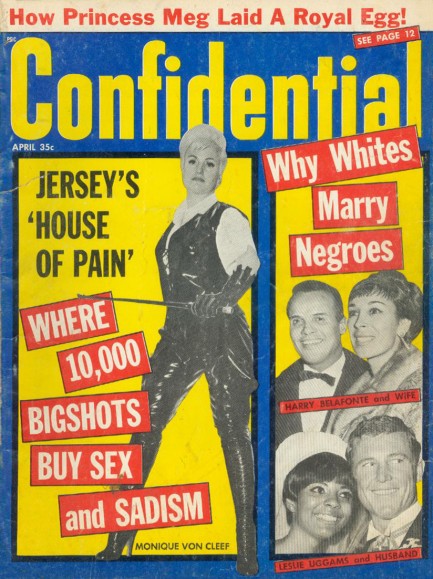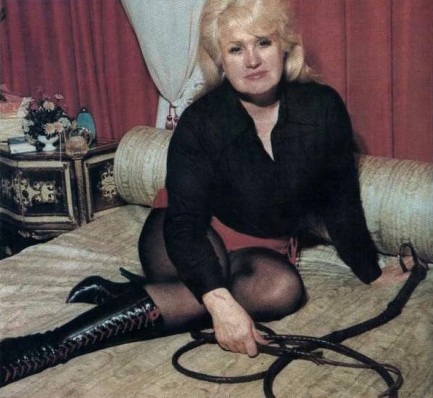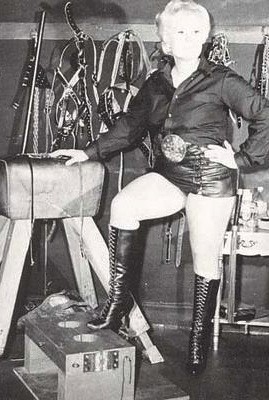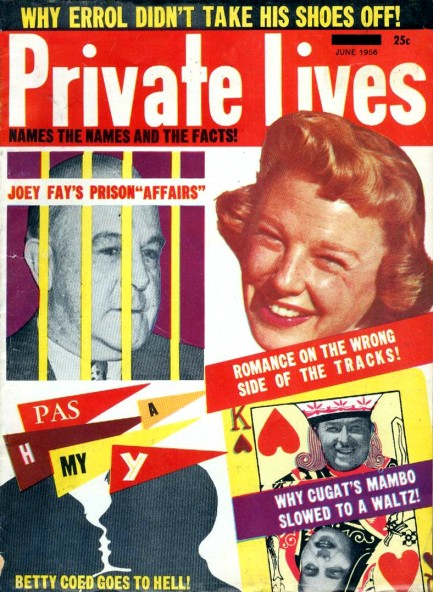| Vintage Pulp | Sex Files | Apr 2 2012 |


In December 1965 in Essex County, New Jersey, local police raided a large home on 850 Lake Street in suburban Newark where they suspected illegal sexual activity was taking place. A detective entered first and met the house’s owner, a Dutch-born former nurse named Monique Von Cleef. The two had reached the point where she had donned a leather jumpsuit and he had stripped to his boxer shorts. At that moment the cops that had been waiting outside stormed into the house. They found that the entire three-story building had been set-up to service practitioners of sado-masochism. Von Cleef had been running the place for years, and had made a nice business out of punishing submissives—among them doctors, local officials, and many New York businessmen. According to court documents, her file cabinet contained 2,000 names.
The story exploded across America—virtually nobody had ever imagined a bdsm lifestyle existed in the U.S. The house on Lake Street was given several nicknames by the media, but “House of Pain” is the one that stuck. When the above April 1966 issue of Confidential appeared, Monique Von Cleef was facing trial and staring a prison sentence in the face. However to prosecutors’ chagrin, she couldn’t be brought up for prostitution, so they opted for a raft of charges related to lewd conduct, and one charge of possessing obscene materials. Von Cleef was convicted, but saw the decision overturned on appeal before the U.S. Supreme Court. Many accounts of the legal proceedings suggest that powerful men on her client list of 2,000 (or 10,000, if you believe Confidential) exerted influence on her behalf. The truth is her conviction was overturned after justices noted that the police had neglected to obtain a search warrant. The fact that previous appeals had glossed over this fact is actually indicative of how much influence was arrayed against Von Cleef. In any case, the Supreme Court decision made every piece of evidence police had obtained inadmissible. Without those items there was no proof of lewd conduct on the premises, and Von Cleef had never touched the detective.
powerful men on her client list of 2,000 (or 10,000, if you believe Confidential) exerted influence on her behalf. The truth is her conviction was overturned after justices noted that the police had neglected to obtain a search warrant. The fact that previous appeals had glossed over this fact is actually indicative of how much influence was arrayed against Von Cleef. In any case, the Supreme Court decision made every piece of evidence police had obtained inadmissible. Without those items there was no proof of lewd conduct on the premises, and Von Cleef had never touched the detective.
Von Cleef had been free during this process, using her notoriety to financial advantage. In San Francisco, billed as the Queen of Humliation, she had been giving onstage orations/performances about sado-masochism at a North Beach nightclub called Coke’s. As her case was reaching the Supreme Court, U.S. Immigration was working to deport her—a threat of which Von Cleef was well aware. Thus when she won her appeal and the order came through shortly thereafter to ship her back to her native Netherlands, she had already left the U.S. illegally. Some claim that influential former clients were involved in her deportation, wanting her out of the States where she could do them no harm. That’s possible, but telephones, teletypes, and televisions reached all the way to Holland back then, which meant that if she had wanted to expose her clients she could just as easily have done it from there. She was deported because that’s what U.S. authorities have always done to alien felons. In Von Cleef’s case, though she had won her appeal, she had overstayed her visa.
then, which meant that if she had wanted to expose her clients she could just as easily have done it from there. She was deported because that’s what U.S. authorities have always done to alien felons. In Von Cleef’s case, though she had won her appeal, she had overstayed her visa.
American tabloids soon moved on to other diversions, and American society followed suit, but Von Cleef maintained a high profile internationally. She opened another dungeon, became a Baroness, wrote a book, appeared in a documentary, and traveled the world promoting her lifestyle. She died in Antwerp, Belgium in 2005, a woman who had gone from nurse to dominatrix, underground to overexposed, and ridden the crazy carousel of American jurisprudence, yet in the end survived and even thrived. One might ask how it was possible, but it seems clear that within her community she was revered from almost the moment she entered it, and she probably enjoyed copious moral and financial support through all her travails. The website dominafiles.com explains best how loyal Von Cleef’s followers were: “What her antagonists didn’t realize was that once an affluent masochist heard about Monique, no matter how, he would travel almost anywhere to see her.”
| The Naked City | Oct 23 2011 |


In previous decades, lawmen had a macabre habit of posing for photos around the corpses of dead criminals. In this case, the criminal is Arthur Flegenheimer, better known as Dutch Shultz, seen here on his morgue slab. The lawmen had nothing to do with his death. Shultz’s end was arranged by fellow mobsters afraid he intended to assassinate a U.S. Attorney, an act which they felt would have serious repercussions. Schultz was shot once below the heart in the men’s room of the Palace Chophouse in Newark, New Jersey. He made it to the hospital alive and survived for about a day, but even if doctors had treated him effectively—which they didn’t—Schultz would have died. His killer had deliberately used rust-coated bullets that would have brought on septicemia. It was untreatable at that time, today, 1935.
| Intl. Notebook | Jun 1 2011 |


This issue of Private Lives from June 1956 with its cover story about Joey Fay teaches us the basic facts of plausible deniability as it works in the political arena. Fay was vice president of the A.F.L. International Union of Operating Engineers based in New York, and in 1945 he was hit with an eighteen-year sentence to Sing Sing Prison for extortion. Within months rumors sprang up that even though he was behind bars he was still running rackets in New York City. A second scandal involving Fay's involvement in crooked horse racing finally prompted some clever reporter, curious who was relaying directives between Sing Sing and NYC, to come up with the genius idea of requesting a list of his visitors. That list turned out to be pure dynamite—it was a roster of practically every prominent east coast politician and official within a two-hundred mile radius. We’re talking the majority leader in the state senate, acting lieutenant governor George Wicks, a former state supreme court justice, state senator William Condon, the mayor of Jersey City, the former mayor of Newark, and on and on. Eighty-seven callers in total, whose visits comprise the “affairs” Private Lives speaks of on its cover.
The embarrassing revelation produced three results. First, the politicians and officials who had visited Fay were forced to concoct highly improbable excuses that the public nevertheless had to accept because nobody knew the exact content of their conversations. Wicks explained his visit this way: “I never consulted or talked with Joseph Fay about anything else but labor conditions in the counties I represent.” See how that plausible deniability stuff works? The second result of the scandal was that Fay was transferred 250 miles upstate to Clinton Prison in Dannemora, NY, where conditions were not nearly as nice as at Sing Sing and he was considerably harder to visit. And third, public officials nationwide stopped visiting criminals in prison. Go and figure. And if there was a fourth result, possibly it was this: a generation of New York voters learned what every generation of voters always re-learns—politicians are exactly as corrupt as lack of scrutiny allows them to be.
| Sportswire | Jul 27 2009 |






































































